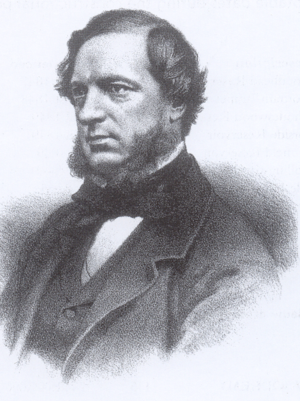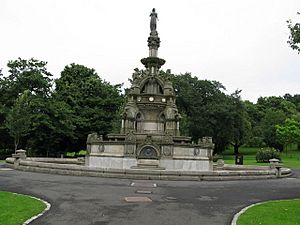John Frederick Bateman facts for kids
Quick facts for kids
John Frederick Bateman
|
|
|---|---|

John Bateman in 1859
|
|
| Born | 30 May 1810 Lower Wyke, Halifax, England
|
| Died | 10 June 1889 (aged 79) Farnham, Surrey, England
|
| Nationality | English |
| Occupation | Engineer |
| Spouse(s) | Anne Fairbairn |
| Parent(s) | John Bateman and Mary Agnes La Trobe |
| Engineering career | |
| Discipline | Civil |
| Institutions | Institution of Civil Engineers (president), Royal Society (fellow), Royal Society of Edinburgh (fellow), Royal Geographical Society (fellow), Geological Society (fellow), Society of Arts (fellow), Royal Institution (fellow) |
John Frederick La Trobe Bateman (born 30 May 1810 – died 10 June 1889) was a very important English civil engineer. He helped create the modern water supply system in the United Kingdom. For over 50 years, starting in 1835, he designed and built many reservoirs and waterworks.
His biggest project was the Longdendale Chain system. This system has supplied Manchester with much of its water since the 1800s. Building this chain of reservoirs, which was the largest in the world at the time, began in 1848 and finished in 1877. Bateman became known as "the greatest dam-builder of his generation."
Bateman also worked on water supply systems for many other cities. These included Glasgow, Belfast, Bolton, Chester, Dublin, Newcastle upon Tyne, Oldham, Perth, Stockport, and Wolverhampton. He also took on projects in other countries. For example, he designed a drainage and water supply system for Buenos Aires. He also created water supply plans for Naples, Constantinople (now Istanbul), and Colombo.
He was the President of the Institution of Civil Engineers in Britain in 1878 and 1879. In 1883, Bateman added his mother's family name, La Trobe, to his own. He became John Frederic La Trobe Bateman.
Contents
His Life
John Bateman was born on 30 May 1810. His birthplace was Lower Wyke, a Moravian Church community near Bradford. He was the oldest son of John Bateman and Mary Agnes. His mother's father, Benjamin La Trobe, was also a member of the Moravian Church.
John spent his early years in the Moravian community. He went to Moravian schools in Fairfield and Ockbrook. In 1825, he started learning to be a surveyor and mining engineer in Oldham. This is called an apprenticeship.
On 1 September 1841, he married Anne. She was the only daughter of Sir William Fairbairn. They had three sons and four daughters. In 1883, he officially changed his name to include "La Trobe." This was to honor his grandfather. Bateman passed away on 10 June 1889 at his home, Moor Park in Farnham. He had bought this estate in 1859.
His Career
Bateman started his own civil engineering business in 1833. He ran it by himself for many years. From 1881 to 1885, he worked with George Hill as a partner. In 1888, he brought his son-in-law, Richard Clere Parsons, and his son, Lee La Trobe Bateman, into the business.
Bateman became a member of the Institution of Civil Engineers on 23 June 1840. He later served as its president in 1878 and 1879. He was also chosen as a fellow of the Royal Society in 1860. He was a fellow of many other important groups too. These included the Royal Society of Edinburgh and the Royal Geographical Society.
Early Engineering Work
In 1834, Bateman looked into why the River Medlock kept flooding. This led him to study hydraulic engineering, which is about how water moves. In 1835, he worked with Sir William Fairbairn. They designed reservoirs on the River Bann in Ireland. From then on, he spent most of his time building reservoirs and waterworks.
In all his projects, he preferred soft water over hard water. He also liked using gravity to move water when possible. This avoided the need for expensive pumping. He paid close attention to how rainfall was measured. He collected a lot of information on this topic and wrote several papers about his findings.
Supplying Water to Manchester
Bateman's biggest water project was supplying water to Manchester and Salford. This involved building a chain of reservoirs in Longdendale. He was first asked about this idea in 1844. By 1846, he had a plan to get water from the Pennine hills. Work began in 1848 and finished in the spring of 1877.
The Longdendale Chain was designed for a smaller population than Manchester had in 1882. So, more water sources were needed. Bateman suggested getting water from Thirlmere in the Lake District. A bill to allow this was first rejected by parliament in 1878 but passed in 1879. Bateman oversaw these new works, with help from George Hill.
In 1884, Bateman wrote a book called History and Description of the Manchester Waterworks.
Loch Katrine and Milngavie Waterworks

In 1852, the Glasgow Council asked Bateman for advice on their water supply. From 1854 to 1855, Bateman advised them to get water from Loch Katrine. A bill was passed to allow this. Work started in the spring of 1856 and was completed by March 1860.
These waterworks stretched over 34 miles. James Morris Gale said they could "bear comparison with the most extensive aqueducts in the world." This included even the famous ones from ancient Rome.
Other Important Projects
In 1855, Bateman wrote a paper for the British Association. It was called On the present state of our Knowledge on the Supply of Water to Towns. In it, he explained the problem of supplying water to cities. He also talked about different ways to get water and their pros and cons.
In 1865, he published a booklet called On the Supply of Water to London from the Sources of the River Severn. This was a plan he designed and surveyed himself. A royal commission in 1868 supported his project. It was a gravity-fed system designed to bring 230 million gallons of water a day to London.
Bateman also worked with many harbor and dock groups across the British Isles. He was a consulting engineer for the Clyde Navigation Trust. He also worked for the government on the Shannon Inundation Inquiry in 1863.
Besides his work in Britain, Bateman completed several projects abroad. In 1869, he wrote a booklet called Channel Railway with Julian John Révy. In it, they suggested building a submarine railway between France and England. It would be inside a cast-iron tube.
In the same year, he represented the Royal Society at the opening of the Suez Canal. He wrote a report about his visit, which was published in the Proceedings. In the winter of 1870, he visited Buenos Aires. The Argentine government asked him to design harbor works for the city. His plans were not used, but he was hired to design and build drainage and water supply systems for the city.
In 1874, he prepared water supply plans for Naples and Constantinople. He also worked on reclamation projects in Spain and Majorca. Government agents in the colonies hired him in Ceylon (now Sri Lanka). There, he designed works to supply Colombo with water.
He also worked with his assistant, Alfred Moore. Together, they developed the Bateman and Moore's Firecock. This device was used in many large cities and towns.
Commemorations
- In 1955, a street in Sa Pobla, Mallorca, was named Bateman. This honored his work in Albufera de Mallorca.
- In November 2005, a special stone was placed at the Milngavie Waterworks. This was done by the Institution of Civil Engineers to remember him.
- On 15 September 2000, a blue plaque was put on the deepest air shaft of the Mottram Tunnel. This tunnel is a long pipeline connecting two river valleys. The plaque says:
John Frederick La Trobe Bateman
(1810–1889)
Pioneer – Water Engineer extraordinaire
Brought water to the taps of Tameside and Manchester by constructing the six mile long chain of Longendale Reservoirs from 1848.
At the time these became the largest reservoirs constructed in the world and Europe's first major conservation scheme.
Completed in 1877, these waters have never run dry. This plaque is located on the deepest air shaft over Mottram Tunnel, measured at some 200 ft below.
See also


